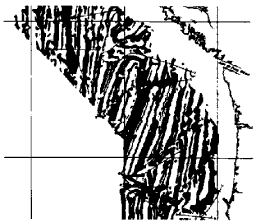 |
Science Frontiers ONLINE No. 124: Jul-Aug 1999 |
|
|
Magnetic Stripes On Mars
As the Mars Global Surveyor swooped down to altitudes between 100 and 200 kilometers above the Martian surface during its aerobraking orbits, magnetometers detected broad, parallel stripes with alternating magnetic polarity. These stripes across the planet's southern highlands are a great surprise to planetologists because they superficially resemble the magnetic stripes that parallel the rifts along the floors of the earth's oceans where new crust is forming. The obvious implication is that Mars once possessed drifting continents and a geomagnetic dynamo that occasionally reversed its polarity -- just as has supposedly happened and is still happening on earth. Prior to this discovery, Mars was deemed too small to have possessed a heat-driven geodynamo, and there is no obvious surface evidence of drifting continents.
Easy as it is to conclude that Martian continents once sailed ponderously cross the planet's surface, the scientific jury is still out. First of all, the Martian magnetic stripes are substantially different from earth's in shape, pattern, strength, and, above all, size. The Martian stripes are about 200 kilometers wide and 2,000 long -- much larger than earth's. Their magnetic field strength is more than ten times that of the terrestrial stripes. Whatever magnetic phenomena occurred on Mars some 4 billion years ago must have been quite different from what happened on earth 200 million years ago. Yet, no other reasonable explanation has been found for the Martian magnetic stripes.
(Acuna, M.H., et al; "Global Distribution of Crustal Magnetization Discovered by the Mars Global Surveyor MAG/ER Experiment," Science, 284:790, 1999. Cowen, Ron; "Plate Tectonics...on Mars," Science News, 155:284, 1999. Recer, Paul; "Mars May Have Been Earth-Like," Northwest Florida Daily News, April 30, 1999. Cr. R. Reid.)
Comment. Actually, the earth's geodynamo is not perfectly understood, especially its tendency to quickly reverse polarity. We may not know what is really happening inside the earth either.
| These terrestrial magnetic stripes off the north-western coast of North America are much narrower, much shorter, and considerably weaker than the 2,000 kilometer long magnetic stripes on Mars. |  |